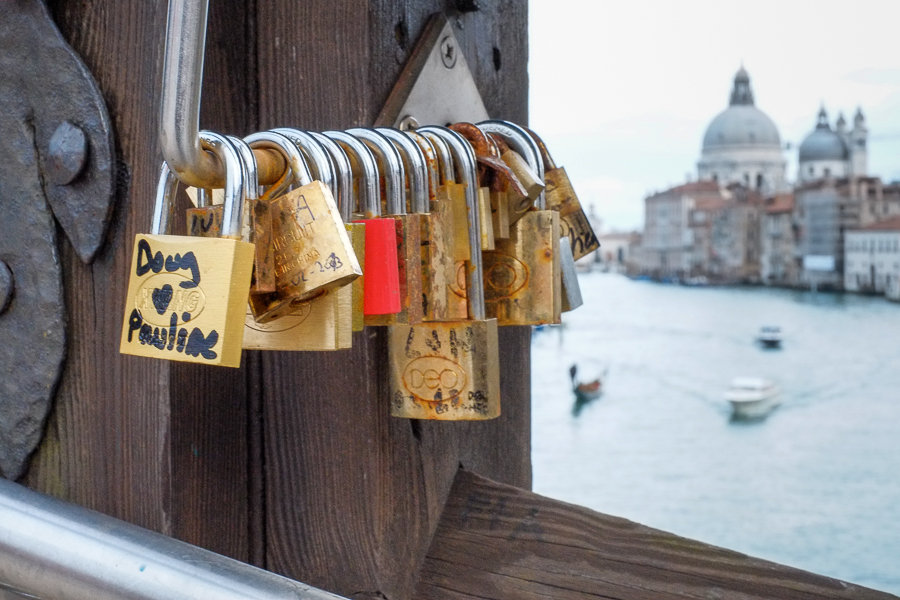Everyone knows that people on vacation, let loose from the rigors of their daily lives and desperate for a good time, are prone to do some pretty dumb things. And as everyone has long known—from the ancient Greeks, through Shakespeare, to Hollywood’s newest writer of romantic comedies—people in love are equally prone to inadvisable behavior, if not downright lunacy. When these two categories of people overlap in one of the most romantic cities in the world what you end up with is an ugly ton’s worth of locks on Venice’s bridges.
Lucchetti dell’amore is what they’re called in Italian, and the phrase’s musicality is not only far prettier than the rather lunkish English “love locks” (which suggests a pulpy soft-core bondage paperback of the 1970s), but than the actual sight of them clotting the sides of Venice’s Accademia Bridge like so many brass barnacles. The custom consists of two lovers writing their names on a padlock, securing the lock to a bridge, then throwing the keys to the lock into the water below. I suppose the symbolism might be that the bond of the lovers will forever transcend the changing river of Time. But, actually, I doubt most people who indulge in this now widespread act get much beyond thinking of it as a public display of their attachment.
In Western Europe the custom is often attributed to an Italian romance novel published in the early 2000s and subsequently made into a film, but its origins actually seem to lie further back. In Serbia, for example, it’s associated with a tale of doomed love that predates World War II. In both France and Germany most attempts by local authorities to remove the locks, which they consider acts of vandalism, from public bridges have met with vocal opposition. But I can wholeheartedly assure you that Venetians have no such sentimental affection for the custom or for those who inflict it upon the city.
On the contrary, to Venetians such locks are simply another of the numerous signs that far too many of the more than 20 million tourists who blow through their fragile city each year have absolutely no respect for its landmarks, its culture, its history, or its residents. That such tourists treat the 1,400-year-old city as nothing more than a stage set on which to act out their own personal though commonplace fantasies, with residents reduced to the roles of cardboard-cutout local color or smiling, flattering panderers.
In August 2011 Venetian outrage over the vast quantities of these locks befouling not only the Accademia Bridge but the iconic Rialto as well, was so great as to embolden some local officials to call for a 3,000 euro fine and a year in jail for offenders. This boiling over was earnestly covered by the international press as though it was the precursor to concrete action. But by March 2013 the locks on the Accademia Bridge were thicker than I’d ever seen them, five illicit vendors of locks brazenly did business there as if the mayor himself had granted them an exclusive franchise, and there was not a single sign posted anywhere in the city informing visitors that attaching a lock to a bridge was illegal, much less threatening even the mildest penalty.
And so the situation remains today. You see, the Accademia Bridge, with its scores of slender stainless steel handrail supports, seems expressly designed for the fad, and visiting lovers need not bother to plan in advance for their public expression of fidelity, or act of vandalism, as the case may be. In fact, they need not even bother to support a local hardware store by buying a padlock and marker there. Instead, like so many of the pleasures of mass tourism, this “unique experience” can be purchased with little thought and even less effort on-site, from a troop of unlicensed vendors who supply everything needed for what might be called this little crime of the heart.
Every now and then the city will crow about a crackdown on such illegal activity on the bridge. Tickets will be issued, a few locks and markers confiscated, but in a matter of days you’ll find the vendors back in their usual spots, keeping an eye out for carabinieri and escaping at no more than a brisk walk down one side of the bridge as the police make their way up the other. As soon as the carabinieri leave the bridge, the vendors return.
There’s little the police can do, it seems, short of installing a permanent sentry. Yet in a city so short on funds it can’t even afford to regularly clean its public schools, both adequate policing and lock removal seem equally beyond its means. While the vendors (who in this case tend to be from Bangladesh) may not have licenses to sell things, they do have the proper documents to be here, as both the local papers reveal after each raid and my Bangladeshi friend who works in a café and knows the vendors tells me. But that’s another, quite complicated story.
Meanwhile, all angry residents can do is take matters into their own hands, in the form of a large industrial-strength bolt cutter. Both individuals and local civic groups have periodically thinned out the ugliness, removing with hard time-consuming labor what tourists have blithely attached in the desire to (as one UK website that sells engraved locks puts it) “simply say we were here!” Such lock removal efforts are considered nothing short of heroic by locals, though inevitably rather Sisyphean. For no sooner are 200 locks cut off over the space of many hours, than 250 more are attached in what amounts to a matter of minutes.
So, if you plan to visit Venice and feel compelled to publicly express your love along ritualistic romantic lines previously laid out in a film, might I instead suggest something taken from 1979’s A Little Romance, starring Laurence Olivier and the young Dianne Lane? According to Olivier’s character in that film, a kiss at sunset in a gondola as it passes beneath the Bridge of Sighs is said to guarantee that a couple’s love will last forever. Now, doesn’t that sound dreamier than buying a cheap lock from some guy with a stinky indelible marker and one eye scanning for cops?
Of course a gondola ride is rather insanely expensive, but two people truly in love are, after all, supposed to be out of their minds.
For more about living in Venice, visit Steven Varni’s blog: veneziablog.blogspot.com































